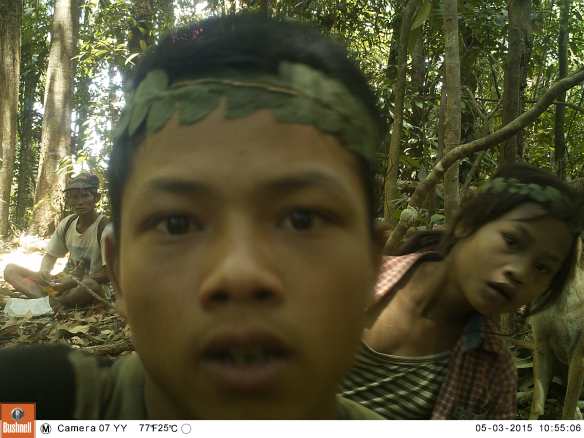 This is a tek-tek, as it’s called by the tribal people of Ratanakiri; in Vietnam just across the border it’s the Nguoi Roung, and in Borneo it’s the Batutut.
This is a tek-tek, as it’s called by the tribal people of Ratanakiri; in Vietnam just across the border it’s the Nguoi Roung, and in Borneo it’s the Batutut.
When I first heard of it I thought it was a version of the neak-ta, the Cambodian spirits who own specific forests and hills and so on, but it’s far more physical:
American soldiers in Vietnam had encounters with what was described as “an orangutan-like creature” … A veteran of the war, now a special investigator for the U.S. Customs Service, who was in Bangkok to investigate the illegal reptile trade, told us that 2 men in his platoon had had their heads torn off by the powerful beast.
(From “The Soul of the Tiger”, in Save Virachey National Park on Face Book).

Tribal children caught on the Habitat ID camera-trap in Virachey. This was four days away from the nearest village – an expedition of over a week, then. An adult in the background, but their approach to child-rearing is markedly different to ours. Possibly these are the tek-tek-makers, although more probably the carving was done by tiger-poachers.
So it’s a cryptid, which is another way of saying nobody knows. The carving was photographed by Greg McCann, a conservationist, who saw it in a remote corner of Cambodia where the borders of Laos and Vietnam meet. “Remote” means days away from the nearest village, the nearest human. There was more than just the carving, too – this is the Phnom Penh Post’s write-up:
It was a loud evening deep in the jungle, the crickets, frogs and odd cicadas were busy playing their usual nighttime symphony. A group of trekkers were getting ready to bunk down for the night.
“My friend was zipped up in his hammock and beginning to doze off, when he noticed that all of the insects had stopped making sounds: the jungle went completely silent,” said Greg McCann, a field coordinator for Habitat ID, a conservation group working in Virachey National Park, where the trekkers were camping.
A few moments later, a horrid smell engulfed the camp – the trekkers all emerged from their tents to find its source. A minute after that, the smell had gone and the insects and frogs returned.

Virachey National Park is one of Cambodia’s last wild places, and Greg McCann’s task is to set camera traps to discover what it holds. Someone has said that Virachey might as well be ground zero for the Earth’s sixth mass extinction event (100,000 species every year), so it’s important:
McCann and his team have been able to document populations of iconic mammal species on the brink of disaster: Asiatic black bear, sun bear, gaur, dhole, stubbed-tail macaque, sambar deer, clouded leopard, and binturong among many others.

In Virachey
The jungles of Laos and Vietnam have been largely hunted out, and Cambodia isn’t far behind – Here’s Our Mr Nixon describing a visit to the pepper plantations near Kampot in the early 1950s:
We took the same road leading to Kep … turned left at a fork onto a dirt road … the road narrowed down to a mere path … made our way on foot … the jungle was thickly populated by tigers and wild boars…”
 Not any more it isn’t – now it’s simply thickly populated. People are the problem, they refuse to share and won’t play nicely. But they can also be the solution:
Not any more it isn’t – now it’s simply thickly populated. People are the problem, they refuse to share and won’t play nicely. But they can also be the solution:
Habitat ID is hoping to create an ecotourism model around Virachey to incentivize the local populations away from the illegal logging, poaching, and mining that is decimating the ecosystem. … “Virachey is truly one of the last bastions of wildlife in Indochina [says McCann]]. And with its upland savannah hills it is one of the most beautiful places in Southeast Asia.”

Kevet tribal house – expeditions into Virachey set out from and return to this village.
Whether the tek-tek still roams those hills I do not know, but Virachey is worth saving even without head-ripping cryptids. It’s getting late – in the 1990s there were tigers in the forests, but they’ve go the way of the tigers of Kampot. If you’d like to learn more, visit the Save Virachey National Park website – updates, videos, stories, invitations to join forthcoming expeditions, and a donation button towards the bottom of the page.
Sources:
• Chelsea Chapman, Tek-Tek, the Yeti of Cambodia, Phnom Penh Post, 8 November 2014
• Save Virachey National Park, Facebook.com
• Aaron Lowinger, Fundraiser for Habitat ID in Virachey National Park, Dailypublic.com

Nice piece, I have never seen a tek tek, but will look out for them.
I’m thinking of selling very top-end tours to Virachey in search of them. Cameras only, of course.